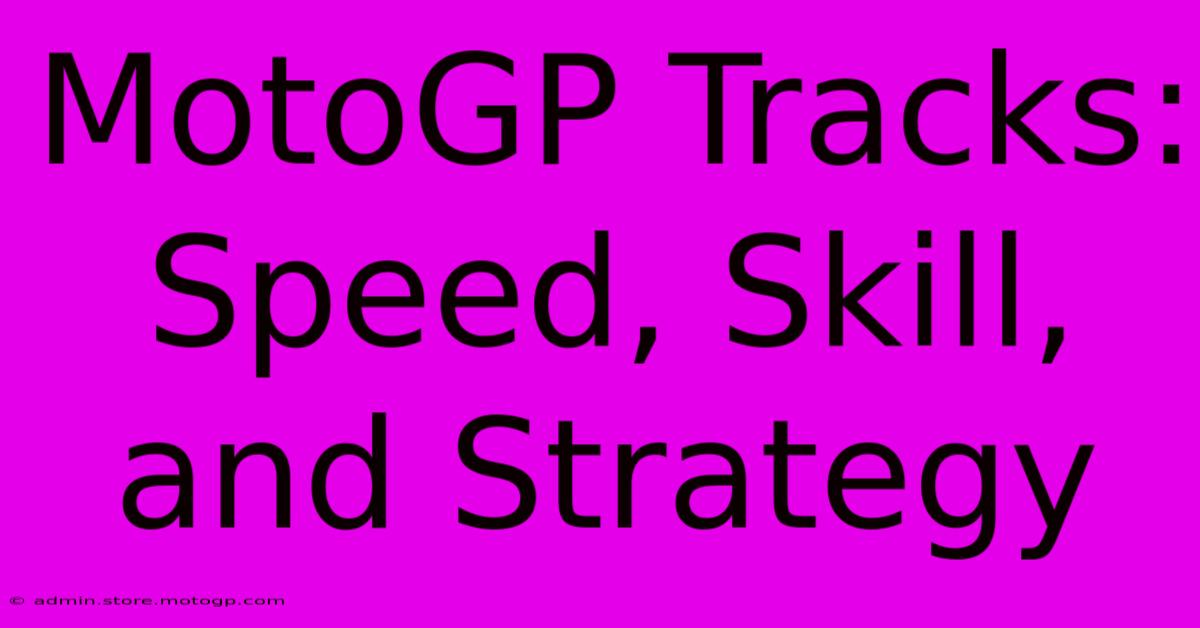MotoGP Tracks: Speed, Skill, And Strategy

Table of Contents
MotoGP Tracks: Speed, Skill, and Strategy
MotoGP, the pinnacle of motorcycle road racing, demands a potent blend of speed, skill, and strategic thinking. But the racing isn't just about the riders; the tracks themselves play a crucial role, each presenting unique challenges and opportunities that shape the race narrative. From the flowing curves of Assen to the daunting twists of Mugello, the circuits are as much characters in the MotoGP story as the riders themselves. This article delves into the multifaceted influence of MotoGP tracks on the sport.
The Anatomy of a MotoGP Track: More Than Just Turns
A MotoGP track isn't just a collection of turns; it's a complex interplay of straights, corners, elevation changes, and runoff areas. Each element contributes to the overall character and difficulty of the circuit.
Straights: The Speed Demons' Domain
The straights are where riders reach top speed, showcasing the raw power of their machines. Top speed isn't just about horsepower; aerodynamic efficiency and rider skill in maintaining stability at such high velocities are equally crucial. Longer straights favor bikes with superior horsepower and aerodynamic packages, while shorter straights reward precise acceleration and braking. Tracks like the Qatar Losail International Circuit, known for its long straights, often see different strategies employed to maximize overtaking opportunities.
Corners: A Ballet of Braking and Balance
Corners are where the true skill of a MotoGP rider is revealed. They aren't just about turning; they're about precise braking, impeccable body position, and the ability to maintain bike control while leaning at extreme angles. Different corner types—hairpins, chicanes, esses, and high-speed sweeps—demand different techniques and bike setups. The Circuit de Barcelona-Catalunya, with its mix of slow and fast corners, tests every aspect of a rider's skills.
Elevation Changes: The Unexpected Twist
Many MotoGP tracks incorporate elevation changes, adding another layer of complexity to the challenge. Ups and downs affect traction, acceleration, and braking, requiring riders to constantly adjust their riding style and bike setup. The Red Bull Ring in Austria, with its significant elevation changes, is a prime example of how topography influences the race.
Strategic Implications of Track Design
The design of a MotoGP track significantly impacts race strategy. The distribution of straights and corners, the nature of the corners themselves, and the presence of elevation changes all contribute to the potential for overtaking and the overall flow of the race.
Overtaking Opportunities: Where the Action Is
Tracks with abundant overtaking opportunities generally produce more exciting races. These opportunities often arise at the exit of corners or on long straights. Tracks like the Algarve International Circuit in Portugal are known for their numerous overtaking possibilities.
Tire Management: A Crucial Consideration
The demands of a track – whether it features numerous hard braking zones, high-speed corners, or long straights – significantly affect tire wear and degradation. Riders and teams must carefully choose tire compounds based on the specific track characteristics to optimize performance and tire life. The Sepang International Circuit in Malaysia, with its high temperatures and demanding layout, is notorious for its impact on tire wear.
Mechanical Setups: Tailored for Each Track
Each MotoGP track requires a tailored bike setup to maximize performance. The suspension, engine mapping, and aerodynamic settings must be optimized for the specific characteristics of the track. The Indianapolis Motor Speedway, with its combination of high-speed corners and long straights, presents a unique setup challenge.
Conclusion: The Dynamic Dance of Track and Rider
The interplay between MotoGP tracks and the riders who conquer them is a dynamic dance of speed, skill, and strategy. Understanding the nuances of each circuit—its straights, corners, and elevation changes—is crucial to appreciating the complexity and excitement of this thrilling motorsport. The constant evolution of both rider skill and track design ensures that MotoGP remains a captivating spectacle year after year.

Thank you for visiting our website wich cover about MotoGP Tracks: Speed, Skill, And Strategy. We hope the information provided has been useful to you. Feel free to contact us if you have any questions or need further assistance. See you next time and dont miss to bookmark.
Featured Posts
-
Moto Gp Sprint Results A Thrilling Battle To The Finish
Feb 20, 2025
-
The Sound Of Victory F1 Concert Live
Feb 20, 2025
-
Moto2 The Championship That Keeps You On The Edge Of Your Seat
Feb 20, 2025
-
Austin Grand Prix Parking The Fastest Way To Get To The Race
Feb 20, 2025
-
From Zero To Hero The Journey Of Motorcycle Grand Prix Winners
Feb 20, 2025
